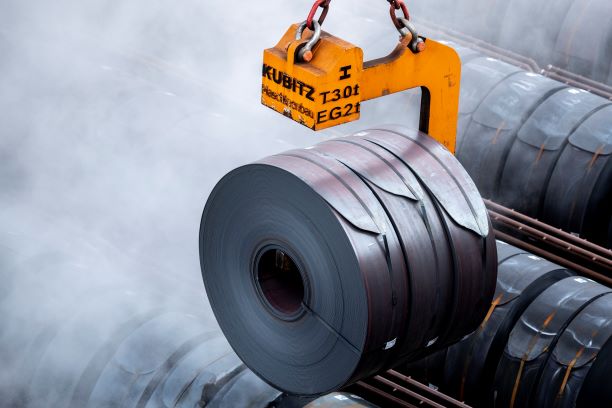Next step towards the smart factory:
by Hans Diederichs

tk digitizes cooling process of steel coils in Hohenlimburg
thyssenkrupp Hohenlimburg (tk) is considered a perfect example of digitization of the rolling mill process. Now the precision steel specialist has reached another milestone: The shower cooling area, where coils are cooled off before passing on to the pickling line, was integrated into the existing digital structure in 2020. This allows to further reduce the lead times of the hot-rolled precision strip significantly. Since November 2020, the shower cooling area has existed as a “digital twin“, a mathematical image of the real site, and the cooling of hot strip is no longer left to chance: the system signals a coil’s readiness to be further conveyed and processed – and this as a function of its temperature.
Worldwide unique process
The water shower cooling has several advantages over the conventional air cooling process. “We were able to reduce lead times significantly, from 72 on average to only five to six hours“, says Thomas Westermann, Head of Maintenance and Logistics who has played an instrumental role in the implementation of the new process. Quality defects like corrosion pits can be avoided by the controlled cooling process. Another important feature is that the coils are cooled down in the shower cooling area and the storage area preceding the pickling line only to the extent that is optimal for the pickling process. The basis for this - apart from the consolidation of various process data - is a self-developed mathematical model on the basis of which each individual coil "knows" when it reaches the optimum temperature. The globally unique method thus has two important benefits: it optimizes warehouse logistics and increases productivity in the manufacturing process. "Something like this only works if you have a reliable database," explains Head of IT Ulrich Schneppe. "This is the result of many years of detail work. But now the data tracking and tracing helps us link process parameters even more precisely to the material flow, and to continuously get better also in future.” This means that it is always possible to see where a specific coil is located on the plant floor. The forklift is also integrated in real time.
Closing the digital gap
With the digitization, the precision steel specialist follows the path toward a fully connected steelworks and creates the conditions for giving customers extensive scope of action in the future. Under the catchword “Rolling as a service“, customers are already today involved in determining what’s next up on the Hohenlimburg site’s rolling program. Short lead times are essential to ensure that this business model also works without large inventories. ”Until now, we lacked the digital link between the rolling mill and the material tracking systems of our two pickling lines. We have significantly reduced this gap with the warehouse management system shower cooling area", explains Ulrich Schneppe. In the coming months, the storage area upstream of the pickling line will be the last area to be integrated. After that, the entire logistics process can be digitally mapped, controlled and managed, from slab loading in Duisburg down to pickling in Hohenlimburg.
Benefit for occupational safety and health
The digital warehouse management system also meets with a positive response from the employees. It enables forklift drivers to spot or deposit coils more quickly and provides information about where the load can be deposited safely – a benefit for occupational safety and health. “The more often you use the digital tools, the more you appreciate their benefits“, says Thomas Westermann. “It starts with the optimization of logistics processes and ends with controlling, where information on material stocks, turnover rates and tied up capital can be easily retrieved.
Source and photo: thyssenkrupp

